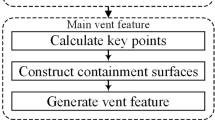Abstract
As the required accuracy of mold flow analysis has recently increased, it has become necessary to consider all components of a mold base and to generate solid meshes for all of them. If holes on all mold components are kept in mesh generation, the mesh size near each hole must be adapted to maintain the shape accurately. This, however, not only increases the effort required to edit the meshes, but also increases the total amount of meshes tremendously. The objective of this study is to present a method for the recognition and suppression of holes on mold bases. A preliminary computation of the data required for hole recognition is described, which includes entity grouping, fillet recognition, and loop recognition. An algorithm for recognizing holes on all mold components can thus be implemented, which includes the recognition of all face compositions on various kinds of “ladder” structures that involve several holes connected to each other. All hole structures can then be suppressed automatically. The recognition and suppression of holes on two mold bases are presented to demonstrate the feasibility of the proposed technique.




















Similar content being viewed by others
References
Ansaldi S, Floriani LD, Falcidieno B (1985) Geometric modeling of solid objects by using a face adjacency graph representation. Comp Graph (ACM) 19:131–139
Joshi S, Chang TC (1988) Graph-based heuristics for recognition of machined features from a 3D solid model. Comput Aided Des 20(2):58–66
Tian F, Tian X, Geng J, Li Z, Zhang Z (2010) A hybrid interactive feature recognition method based on lightweight model. In: 2010 international conference on measuring technology and mechatronics automation, pp 113–117
Li J, Sun L, Peng J, Du J, Fan L (2011) Automatic small depression feature recognition from solid B-rep models for meshing. International conference on electrical and control engineering (ICECE), pp 4386–4389
Venkataraman S, Sohoni M (2001) Blend recognition algorithm and applications. The sixth ACM symposium on solid modeling and applications, pp 99–108
Li B, Liu J (2002) Detail feature recognition and decomposition in solid model. Comput Aided Des 34(5):405–414
Cui X, Gao S, Zhou G (2004) An efficient algorithm for recognizing and suppressing blend features. Comput Aided Design Appl 1(1–4):421–428
Li J, Tong G, Shi D, Geng M, Zhu H, Hagiwara I (2009) Automatic small blend recognition from B-rep models for analysis. Eng Comput 25(3):279–285
Joshi N, Dutta D (2003) Feature simplification techniques for freeform surface models. J Comput Inf Sci Eng 3(3):177–186
Sundararajan V, Wright PK (2004) Volumetric feature recognition for machining components with freeform surfaces. Comput Aided Des 36(1):11–25
Sunil VB, Pande SS (2008) Automatic recognition of features from freeform surface CAD models. Comput Aided Des 40(4):502–517
Zhang CJ, Zhou XH, Li CX (2009) Automatic recognition of intersecting features of freeform sheet metal parts. J Zhejiang Univ Sci A 10(10):1439–1449
You CF, Tsai YL, Liu KY (2010) Representation and similarity assessment in case-based process planning and die design for manufacturing automotive panels. Int J Adv Technol 51(1–4):297–310
Li YG, Ding YF, Mou WP, Guo H (2010) Feature recognition technology for aircraft structural parts based on a holistic attribute adjacency graph. Proc Inst Mech Eng Part B J Eng Manuf 224(2):271–278
CADdoctor (2018). http://elysiuminc.com/products/caddoctor/. Accessed on 22 Aug 2018
Lai JY, You ZW, Chiu YK, Wang MH, Hsu CH, Tsai YC (2015) On the development of holes recognition algorithm for CAE applications. Key Eng Mater 656–657:789–794
Wang MH, Lai JY, Chiu YK, Hsu CH, Tsai YC, Huang CY (2015) On the development of virtual inner loops for feature recognition. Key Eng Mater 656–657:761–767
Lai JY, Wang MH, Song PP, Hsu CH, Tsai YC (2018) Recognition and decomposition of rib features in thin-shell plastic parts for finite element analysis. Comput Aided Design Appl 15(2):264–279
Rhinoceros (2018). http://www.rhino3d.com. Accessed on 22 Aug 2018
openNURBS (2018). http://www.rhino3d.com/tw/opennurbs. Accessed on 22 Aug 2018
Author information
Authors and Affiliations
Corresponding author
Additional information
Publisher’s Note
Springer Nature remains neutral with regard to jurisdictional claims in published maps and institutional affiliations.
Rights and permissions
About this article
Cite this article
Song, PP., Lai, JY., Tsai, YC. et al. Automatic recognition and suppression of holes on mold bases for finite element applications. Engineering with Computers 35, 925–944 (2019). https://doi.org/10.1007/s00366-018-0640-4
Received:
Accepted:
Published:
Issue Date:
DOI: https://doi.org/10.1007/s00366-018-0640-4




